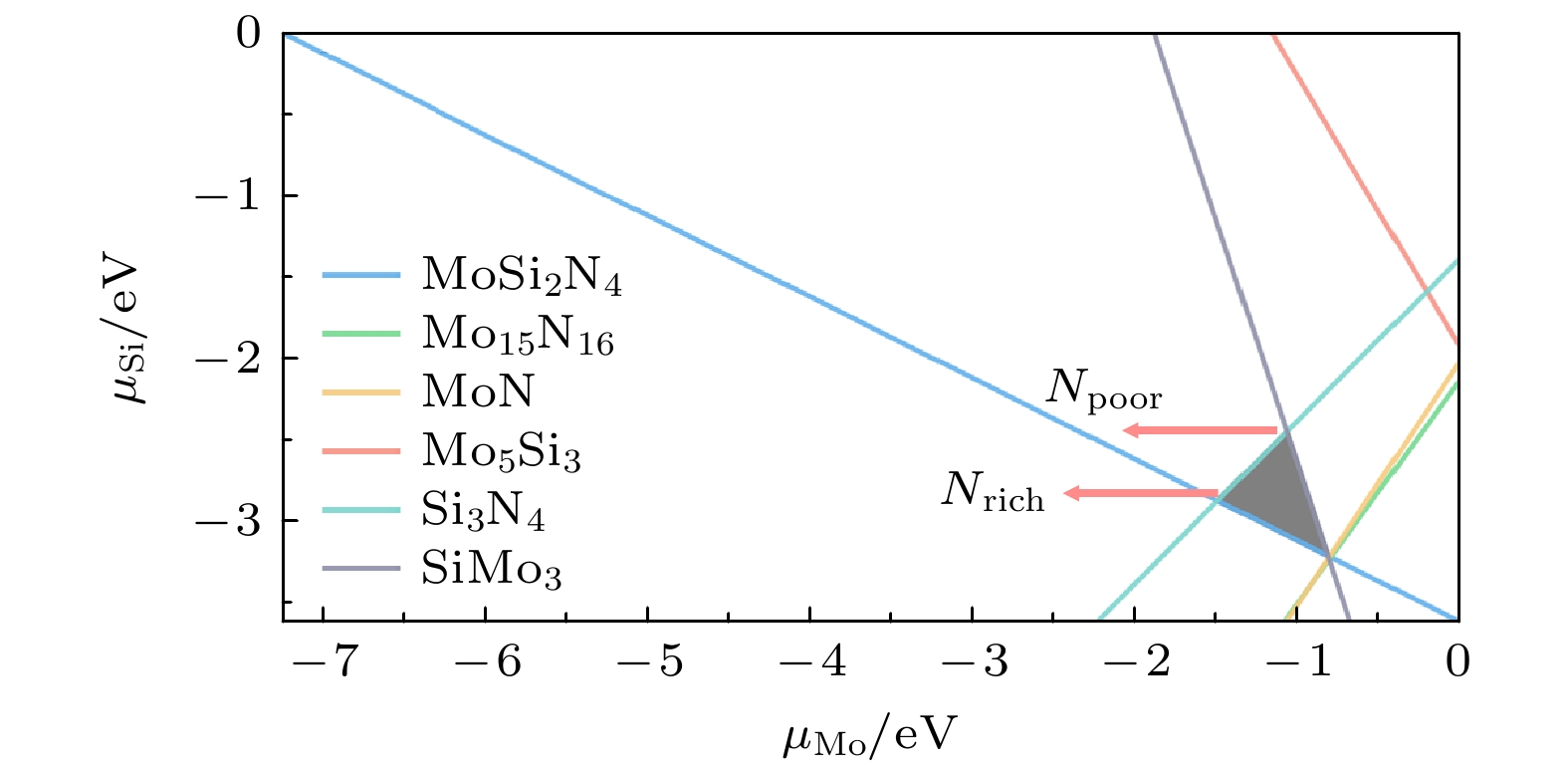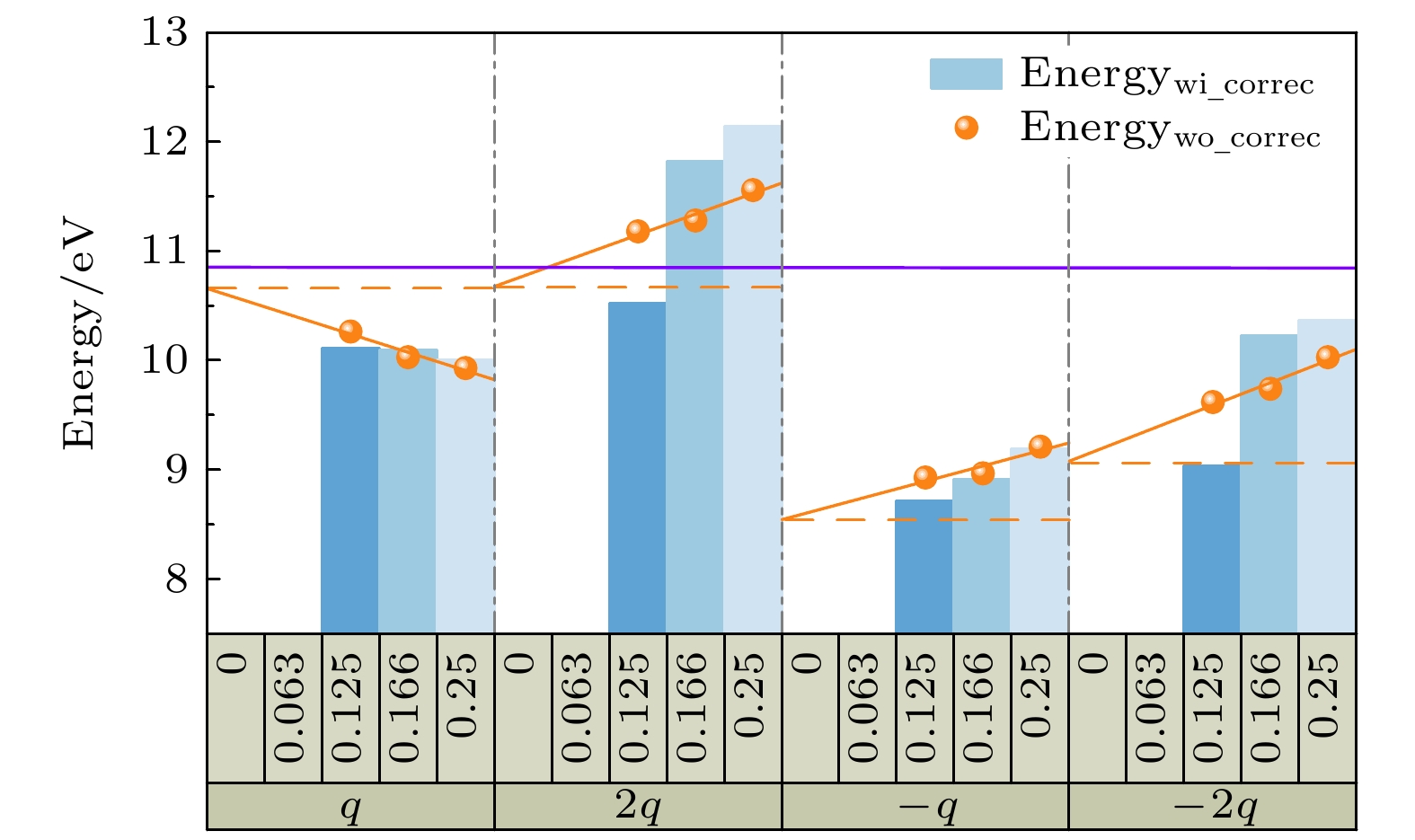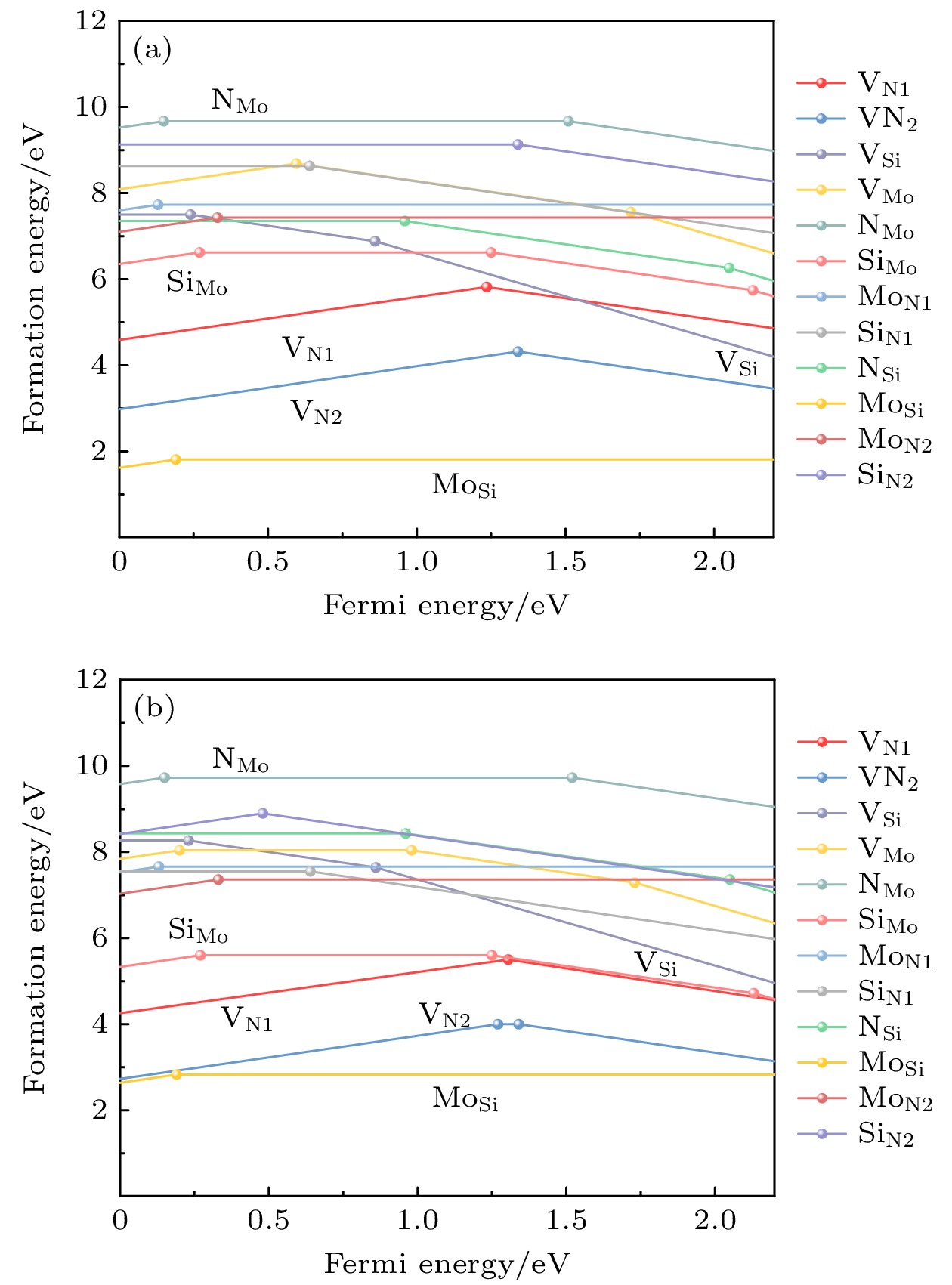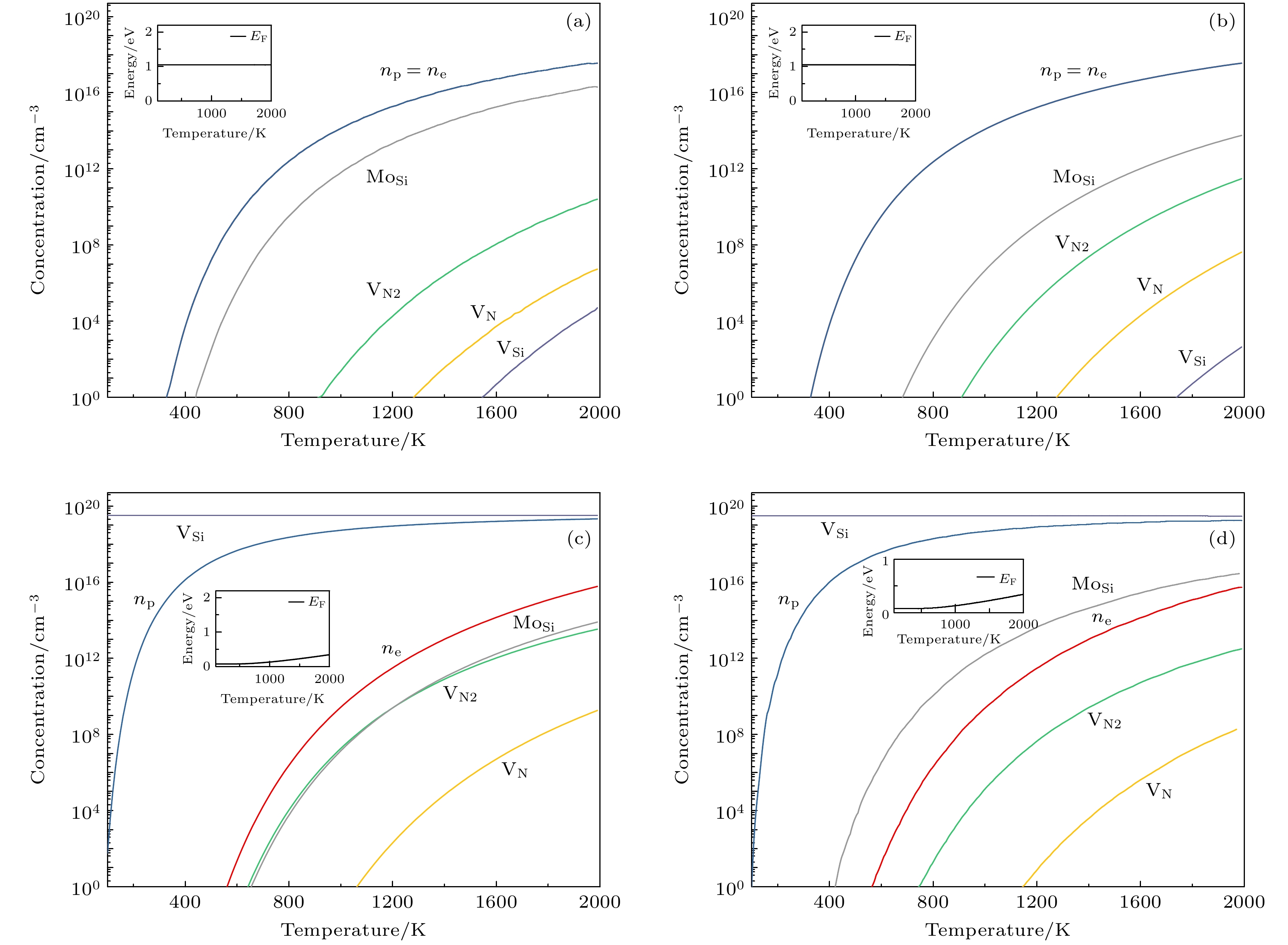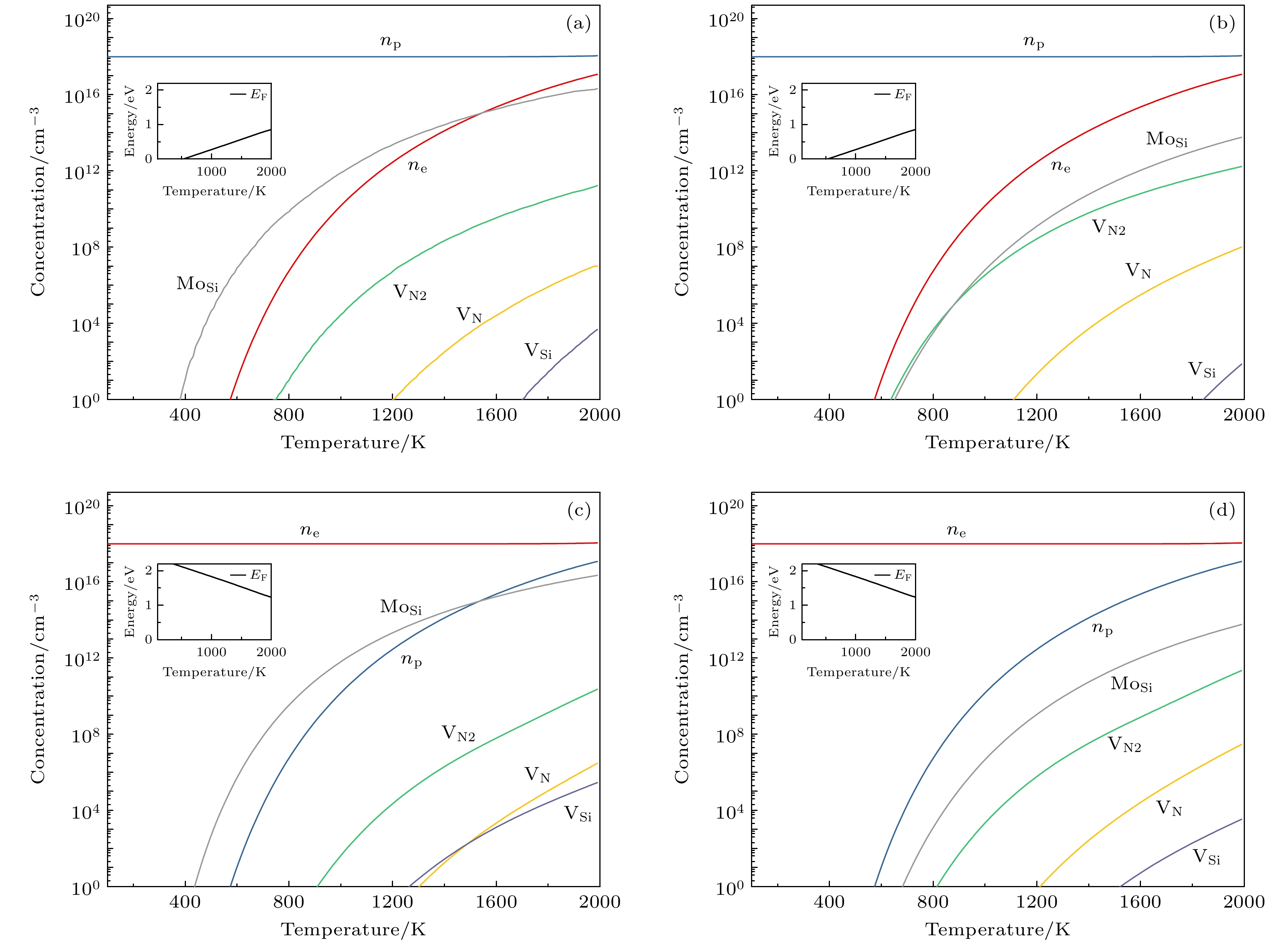-
MoSi2N4 is an emergent two-dimensional (2D) material, which has received much attention because of its excellent performance over semiconductors, including excellent environmental stability and high carrier mobility. However, the formation of intrinsic defects in semiconductors is often inevitable and can significantly affect device performance. By using density functional theory (DFT), we analyze the properties and effects of intrinsic point defects in MoSi2N4. We first confirm the consistency of our results with current experimental data. After that, the formation energy values of twelve native defects reveal that the antisite defect of molybdenum substituting for silicon (MoSi) defect dominates in all intrinsic defects. Under the constraint of overall charge neutrality, self-consistent Fermi level calculations reveal that MoSi2N4 with only intrinsic defects exhibits intrinsic characteristics, highlighting its potential as a semiconductor device material. However, this intrinsic nature contradicts the p-type characteristics observed in two-dimensional MoSi2N4. In the subsequent defect concentrations, we find that both n-type and p-type behavior can be easily realized by doping appropriate impurities without being compensated by native defects. This suggests that the p-type characteristics of MoSi2N4 during growth may result from p-type impurities introduced under non-equilibrium growth conditions or silicon vacancy defects. Our findings not only demonstrate the potential applications of MoSi2N4 in semiconductor devices but also provide valuable guidance for future studying the defect mechanisms of this material.
-
Keywords:
- density functional theory /
- intrinsic defects /
- charged defects energy correction /
- 2-dimensional materials
[1] Hong Y L, Liu Z B, Wang L, Zhou T Y, Ma W, Xu C, Feng S, Chen L, Chen M L, Sun D M, Chen X Q, Cheng H M, Ren W C 2020 Science 369 670
 Google Scholar
Google Scholar
[2] Sun X T, Song Z G, Huo N N, Liu S Q, Yang C, Yang J, Wang W Z, Lu J 2021 J. Mater. Chem. C 9 14683
 Google Scholar
Google Scholar
[3] Huang J, Li P, Ren X, Guo Z X 2021 Phys. Rev. Appl. 16 044022
 Google Scholar
Google Scholar
[4] Nandan K, Ghosh B, Agarwal A, Bhowmick S, Chauhan Y S 2021 IEEE Trans. Electron Devices 69 406
 Google Scholar
Google Scholar
[5] Liu Y B, Zhang T, Dou K Y, Du W H, Peng R, Dai Y, Huang B B, Ma Y D 2021 J. Phys. Chem. Lett. 12 8341
 Google Scholar
Google Scholar
[6] Chi Y H, Chen Z N, Ma H, Yuan S F, Hao C L, Ren H, Zhao W, Zhu H Y, Ling C C, Guo W Y 2023 Appl. Catal. A 650 118975
 Google Scholar
Google Scholar
[7] Xiao C W, Ma Z J, Sa R J, Cui Z T, Gao S S, Du W, Sun X Q, Li Q H 2022 ACS Omega 7 8706
 Google Scholar
Google Scholar
[8] Xiao C W, Sa R J, Cui Z T, Gao S S, Du W, Sun X Q, Zhang X T, Li Q H, Ma Z J 2021 Appl. Surf. Sci. 563 150388
 Google Scholar
Google Scholar
[9] Bafekry A, Faraji M, Fadlallah M, Ziabari A A, Khatibani A B, Feghhi S, Ghergherehchi M, Gogova D 2021 Appl. Surf. Sci. 564 150326
 Google Scholar
Google Scholar
[10] Bafekry A, Faraji M, Fadlallah M M, Khatibani A B, Ziabari A A, Ghergherehchi M, Nedaei S, Shayesteh S F, Gogova D 2021 Appl. Surf. Sci. 559 149862
 Google Scholar
Google Scholar
[11] Ma H, Zhao W, Zhang Q, Liu D Y, Ren H, Zhu H Y, Chi Y H, Ding F, Guo W Y 2022 Appl. Surf. Sci. 592 153214
 Google Scholar
Google Scholar
[12] Hashibon A, Elsässer C 2011 Phys. Rev. B 84 144117
 Google Scholar
Google Scholar
[13] Janotti A, Van de Walle C G 2007 Phys. Rev. B 76 165202
 Google Scholar
Google Scholar
[14] Yang C, Song Z G, Sun X T, Lu J 2021 Phys. Rev. B 103 035308
 Google Scholar
Google Scholar
[15] Xiong J, Di J, Xia J X, Zhu W S, Li H M 2018 Adv. Funct. Mater. 28 1801983
 Google Scholar
Google Scholar
[16] Zheng Y J, Chen Y, Huang Y L, Gogoi P K, Li M Y, Li L J, Trevisanutto P E, Wang Q, Pennycook S J, Wee A T 2019 ACS Nano 13 6050
 Google Scholar
Google Scholar
[17] Komsa H P, Berseneva N, Krasheninnikov A V, Nieminen R M 2018 Phys. Rev. X 8 031044
 Google Scholar
Google Scholar
[18] Kresse G, Furthmuller J 1996 Comput. Mater. Sci 6 15
 Google Scholar
Google Scholar
[19] Kresse G, Furthmuller J 1996 Phys. Rev. B 54 11169
 Google Scholar
Google Scholar
[20] Heyd J, Scuseria G E 2004 J. Chem. Phys. 121 1187
 Google Scholar
Google Scholar
[21] Liu X F, Gao Z B, Wang V, Luo Z J, Lv B, Ding Z, Zhang Z F 2020 ACS Appl. Mater. Interfaces 12 17055
 Google Scholar
Google Scholar
[22] Freysoldt C, Neugebauer J 2018 Phys. Rev. B 97 205425
 Google Scholar
Google Scholar
[23] Li S, Thiering G, Udvarhelyi P, Ivády V, Gali A 2022 Nat. Commun. 13 1210
 Google Scholar
Google Scholar
[24] Sopiha K V, Malyi O I, Persson C, Wu P 2021 ACS Appl. Mater. Interfaces 13 33664
 Google Scholar
Google Scholar
[25] Wang W, Strohbeen P J, Lee D, Zhou C, Kawasaki J K, Choi K S, Liu M, Galli G 2020 Chem. Mater. 32 2899
 Google Scholar
Google Scholar
[26] Buckeridge J 2019 Comput. Phys. Commun. 244 329
 Google Scholar
Google Scholar
[27] Buckeridge J, Veal T D, Catlow C R A, Scanlon D O 2019 Phys. Rev. B 100 035207
 Google Scholar
Google Scholar
[28] Bafekry A, Faraji M, Hoat D M, Shahrokhi M, Fadlallah M M, Shojaei F, Feghhi S A H, Ghergherehchi M, Gogova D 2021 J. Phys. s D Appl. Phys. 54 155303
 Google Scholar
Google Scholar
[29] Yadav P, Khamari B, Singh B, Adarsh K, Agarwal A 2023 J. Phys. Condens. Matter 35 235701
 Google Scholar
Google Scholar
[30] Li S, Wu W K, Feng X L, Guan S, Feng W X, Yao Y G, Yang S A 2020 Phys. Rev. B 102 235435
 Google Scholar
Google Scholar
[31] Brachman M K 1954 J. Chem. Phys. 22 1152
 Google Scholar
Google Scholar
[32] Chen L Q 2019 MRS Bull. 44 520
 Google Scholar
Google Scholar
[33] Zhang S, Wei S H 2002 Appl. Phys. Lett. 80 1376
 Google Scholar
Google Scholar
[34] Berseneva N, Krasheninnikov A V, Nieminen R M 2011 Phys. Rev. Lett. 107 035501
 Google Scholar
Google Scholar
[35] Wang D, Han D, Li X B, Xie S Y, Chen N K, Tian W Q, West D, Sun H B, Zhang S B 2015 Phys. Rev. Lett. 114 196801
 Google Scholar
Google Scholar
[36] Freysoldt C, Neugebauer J, Van de Walle C G 2009 Phys. Rev. Lett. 102 016402
 Google Scholar
Google Scholar
[37] Zhu G J, Yang J H, Gong X G 2020 Phys. Rev. B 102 035202
 Google Scholar
Google Scholar
[38] Wang D, Han D, Li X B, Chen N K, West D, Meunier V, Zhang S, Sun H B 2017 Phys. Rev. B 96 155424
 Google Scholar
Google Scholar
[39] Xiao J, Yang K, Guo D, Shen T, Deng H X, Li S S, Luo J W, Wei S H 2020 Phys. Rev. B 101 165306
 Google Scholar
Google Scholar
[40] Rijal B, Tan A M Z, Freysoldt C, Hennig R G 2021 Phys. Rev. Mater. 5 124004
 Google Scholar
Google Scholar
[41] Tian Z, Zhao M X, Xue X X, Xia W, Guo C L, Guo Y F, Feng Y X, Xue J M 2018 ACS Appl. Mater. Interfaces 10 12831
 Google Scholar
Google Scholar
[42] Komsa H P, Pasquarello A 2013 Phys. Rev. Lett. 110 095505
 Google Scholar
Google Scholar
[43] Komsa H P, Krasheninnikov A V 2015 Phys. Rev. B 91 125304
 Google Scholar
Google Scholar
[44] Zhang S, Wang C G, Li M Y, Huang D, Li L J, Ji W, Wu S 2017 Phys. Rev. Lett. 119 046101
 Google Scholar
Google Scholar
[45] Buckeridge J, Jevdokimovs D, Catlow C, Sokol A 2016 Phys. Rev. B 94 180101
 Google Scholar
Google Scholar
[46] Taylor F H, Buckeridge J, Catlow C R A 2016 Chem. Mater. 28 8210
 Google Scholar
Google Scholar
-
图 3 富氮条件下不同带电(分别标记为q, 2q, –q, –2q)VMo形成能随晶胞扩大倍数(以扩大倍数倒数$ 1/\alpha $的形式呈现, $ \alpha =4, 6, 8 $)变化而改变的示意图, 蓝色柱状图表示FN校正之后的数据, 橘黄色点表示未加FN校正的原始数据点, 而橙色线段表示外推线性方程, 橙色虚线表示使用SVS方法合理外推之后的准确值, 紫线为中性缺陷能量
Figure 3. The Formation energies of different charge states (denote as q, 2q, –q, –2q, respectively) in N-rich condition as a function of the expansion multiple of the unit cell (denote as the reciprocal of the enlargement factor 1/α; α = 4, 6, 8) for $ {{\mathrm{V}}}_{{\mathrm{M}}{\mathrm{o}}} $. Blue bars indicate the data after FN correction, while the orange circles mean data without FN correction. The orange lines represent the extrapolated functions and orange dotted lines represent results of SVS prediction, purple line is the neutral defect energy.
图 4 在(a)富氮和(b)贫氮情况下MoSi2N4不同本征缺陷的形成能随费米能级能量(相对于价带顶的值)变化的示意图, 电荷转变能级出现在各缺陷形成能折线转折处
Figure 4. Formation energies of each intrinsic defect in MoSi2N4 as a function of Fermi energy relative to the valence band maximum (VBM), in (a) N rich and (b) N poor condition. The transition levels lie where the slopes of lines change.
图 5 电子(ne), 空穴(np)和缺陷浓度在(a)富氮和(b)贫氮环境热平衡条件下随着温度变化的情况以及固定硅空位缺陷(VSi)浓度为$ 6\times {10}^{19}~{\mathrm{c}}{{\mathrm{m}}}^{-3} $情况下在(c)富氮以及(d)贫氮环境下的变化情况
Figure 5. Concentrations of electrons (ne), holes (np) and defects in MoSi2N4 as a function of temperature T in equilibrium condition in (a) N-rich (b) N-poor environments respectively and in the presence of a fixed concentration of $ {{\mathrm{V}}}_{{\mathrm{S}}{\mathrm{i}}}=6\times {10}^{19}~{\mathrm{c}}{{\mathrm{m}}}^{-3} $ in (c) N-rich and (d) N-poor environments.
图 6 在固定p型载流子浓度条件下, 在 (a)富氮情况和(b)贫氮情况下电子(ne), 空穴(np)和缺陷浓度随着温度变化的情况; 在固定n型载流子浓度的条件下, (c)富氮情况和(d)贫氮情况下电子, 空穴和缺陷浓度随着温度变化的情况
Figure 6. Concentrations of electron (ne) and hole (np) carriers and defects as a function of temperature T calculated in the presence of a fixed concentration of p carriers in (a) N-rich and (b) N-poor environments and in the presence of a fixed concentration of n carriers in (c) N-rich and (d) N-poor environments.
表 1 由VASP计算所得MoSi2N4相应的参数, 包括沿着x, y, z方向的晶格参数a, b, c及两种不同的Si—N键d12, d3的键长(Å); 带隙Eg及自旋轨道耦合分离能$ {{\Delta }}{Q}_{12} $(eV)
Table 1. The related parameters of MoSi2N4 calculated by VASP, including the lattice parameters along x, y, z direction a, b, c and two different Si—N bond lengths d12, d3 (Å); the bandgap Eg and the spin-orbit split-off energy $ {{\Delta }}{Q}_{12} $(eV).
a, b/Å d1,2/Å d3/Å c/Å $ {\Delta }{\boldsymbol{Q}}_{1, 2}/\mathbf{e}\mathbf{V} $ Eg/eV VBM/CBM Calculation 2.90 1.75 2.08 20.01 0.163 2.17 $ \varGamma /K $ Ref. [30] 2.909 — — 20.00 0.172 2.298 $ \varGamma /K $ -
[1] Hong Y L, Liu Z B, Wang L, Zhou T Y, Ma W, Xu C, Feng S, Chen L, Chen M L, Sun D M, Chen X Q, Cheng H M, Ren W C 2020 Science 369 670
 Google Scholar
Google Scholar
[2] Sun X T, Song Z G, Huo N N, Liu S Q, Yang C, Yang J, Wang W Z, Lu J 2021 J. Mater. Chem. C 9 14683
 Google Scholar
Google Scholar
[3] Huang J, Li P, Ren X, Guo Z X 2021 Phys. Rev. Appl. 16 044022
 Google Scholar
Google Scholar
[4] Nandan K, Ghosh B, Agarwal A, Bhowmick S, Chauhan Y S 2021 IEEE Trans. Electron Devices 69 406
 Google Scholar
Google Scholar
[5] Liu Y B, Zhang T, Dou K Y, Du W H, Peng R, Dai Y, Huang B B, Ma Y D 2021 J. Phys. Chem. Lett. 12 8341
 Google Scholar
Google Scholar
[6] Chi Y H, Chen Z N, Ma H, Yuan S F, Hao C L, Ren H, Zhao W, Zhu H Y, Ling C C, Guo W Y 2023 Appl. Catal. A 650 118975
 Google Scholar
Google Scholar
[7] Xiao C W, Ma Z J, Sa R J, Cui Z T, Gao S S, Du W, Sun X Q, Li Q H 2022 ACS Omega 7 8706
 Google Scholar
Google Scholar
[8] Xiao C W, Sa R J, Cui Z T, Gao S S, Du W, Sun X Q, Zhang X T, Li Q H, Ma Z J 2021 Appl. Surf. Sci. 563 150388
 Google Scholar
Google Scholar
[9] Bafekry A, Faraji M, Fadlallah M, Ziabari A A, Khatibani A B, Feghhi S, Ghergherehchi M, Gogova D 2021 Appl. Surf. Sci. 564 150326
 Google Scholar
Google Scholar
[10] Bafekry A, Faraji M, Fadlallah M M, Khatibani A B, Ziabari A A, Ghergherehchi M, Nedaei S, Shayesteh S F, Gogova D 2021 Appl. Surf. Sci. 559 149862
 Google Scholar
Google Scholar
[11] Ma H, Zhao W, Zhang Q, Liu D Y, Ren H, Zhu H Y, Chi Y H, Ding F, Guo W Y 2022 Appl. Surf. Sci. 592 153214
 Google Scholar
Google Scholar
[12] Hashibon A, Elsässer C 2011 Phys. Rev. B 84 144117
 Google Scholar
Google Scholar
[13] Janotti A, Van de Walle C G 2007 Phys. Rev. B 76 165202
 Google Scholar
Google Scholar
[14] Yang C, Song Z G, Sun X T, Lu J 2021 Phys. Rev. B 103 035308
 Google Scholar
Google Scholar
[15] Xiong J, Di J, Xia J X, Zhu W S, Li H M 2018 Adv. Funct. Mater. 28 1801983
 Google Scholar
Google Scholar
[16] Zheng Y J, Chen Y, Huang Y L, Gogoi P K, Li M Y, Li L J, Trevisanutto P E, Wang Q, Pennycook S J, Wee A T 2019 ACS Nano 13 6050
 Google Scholar
Google Scholar
[17] Komsa H P, Berseneva N, Krasheninnikov A V, Nieminen R M 2018 Phys. Rev. X 8 031044
 Google Scholar
Google Scholar
[18] Kresse G, Furthmuller J 1996 Comput. Mater. Sci 6 15
 Google Scholar
Google Scholar
[19] Kresse G, Furthmuller J 1996 Phys. Rev. B 54 11169
 Google Scholar
Google Scholar
[20] Heyd J, Scuseria G E 2004 J. Chem. Phys. 121 1187
 Google Scholar
Google Scholar
[21] Liu X F, Gao Z B, Wang V, Luo Z J, Lv B, Ding Z, Zhang Z F 2020 ACS Appl. Mater. Interfaces 12 17055
 Google Scholar
Google Scholar
[22] Freysoldt C, Neugebauer J 2018 Phys. Rev. B 97 205425
 Google Scholar
Google Scholar
[23] Li S, Thiering G, Udvarhelyi P, Ivády V, Gali A 2022 Nat. Commun. 13 1210
 Google Scholar
Google Scholar
[24] Sopiha K V, Malyi O I, Persson C, Wu P 2021 ACS Appl. Mater. Interfaces 13 33664
 Google Scholar
Google Scholar
[25] Wang W, Strohbeen P J, Lee D, Zhou C, Kawasaki J K, Choi K S, Liu M, Galli G 2020 Chem. Mater. 32 2899
 Google Scholar
Google Scholar
[26] Buckeridge J 2019 Comput. Phys. Commun. 244 329
 Google Scholar
Google Scholar
[27] Buckeridge J, Veal T D, Catlow C R A, Scanlon D O 2019 Phys. Rev. B 100 035207
 Google Scholar
Google Scholar
[28] Bafekry A, Faraji M, Hoat D M, Shahrokhi M, Fadlallah M M, Shojaei F, Feghhi S A H, Ghergherehchi M, Gogova D 2021 J. Phys. s D Appl. Phys. 54 155303
 Google Scholar
Google Scholar
[29] Yadav P, Khamari B, Singh B, Adarsh K, Agarwal A 2023 J. Phys. Condens. Matter 35 235701
 Google Scholar
Google Scholar
[30] Li S, Wu W K, Feng X L, Guan S, Feng W X, Yao Y G, Yang S A 2020 Phys. Rev. B 102 235435
 Google Scholar
Google Scholar
[31] Brachman M K 1954 J. Chem. Phys. 22 1152
 Google Scholar
Google Scholar
[32] Chen L Q 2019 MRS Bull. 44 520
 Google Scholar
Google Scholar
[33] Zhang S, Wei S H 2002 Appl. Phys. Lett. 80 1376
 Google Scholar
Google Scholar
[34] Berseneva N, Krasheninnikov A V, Nieminen R M 2011 Phys. Rev. Lett. 107 035501
 Google Scholar
Google Scholar
[35] Wang D, Han D, Li X B, Xie S Y, Chen N K, Tian W Q, West D, Sun H B, Zhang S B 2015 Phys. Rev. Lett. 114 196801
 Google Scholar
Google Scholar
[36] Freysoldt C, Neugebauer J, Van de Walle C G 2009 Phys. Rev. Lett. 102 016402
 Google Scholar
Google Scholar
[37] Zhu G J, Yang J H, Gong X G 2020 Phys. Rev. B 102 035202
 Google Scholar
Google Scholar
[38] Wang D, Han D, Li X B, Chen N K, West D, Meunier V, Zhang S, Sun H B 2017 Phys. Rev. B 96 155424
 Google Scholar
Google Scholar
[39] Xiao J, Yang K, Guo D, Shen T, Deng H X, Li S S, Luo J W, Wei S H 2020 Phys. Rev. B 101 165306
 Google Scholar
Google Scholar
[40] Rijal B, Tan A M Z, Freysoldt C, Hennig R G 2021 Phys. Rev. Mater. 5 124004
 Google Scholar
Google Scholar
[41] Tian Z, Zhao M X, Xue X X, Xia W, Guo C L, Guo Y F, Feng Y X, Xue J M 2018 ACS Appl. Mater. Interfaces 10 12831
 Google Scholar
Google Scholar
[42] Komsa H P, Pasquarello A 2013 Phys. Rev. Lett. 110 095505
 Google Scholar
Google Scholar
[43] Komsa H P, Krasheninnikov A V 2015 Phys. Rev. B 91 125304
 Google Scholar
Google Scholar
[44] Zhang S, Wang C G, Li M Y, Huang D, Li L J, Ji W, Wu S 2017 Phys. Rev. Lett. 119 046101
 Google Scholar
Google Scholar
[45] Buckeridge J, Jevdokimovs D, Catlow C, Sokol A 2016 Phys. Rev. B 94 180101
 Google Scholar
Google Scholar
[46] Taylor F H, Buckeridge J, Catlow C R A 2016 Chem. Mater. 28 8210
 Google Scholar
Google Scholar
-
 8-20231931Suppl.pdf
8-20231931Suppl.pdf

Catalog
Metrics
- Abstract views: 6571
- PDF Downloads: 923
- Cited By: 0
















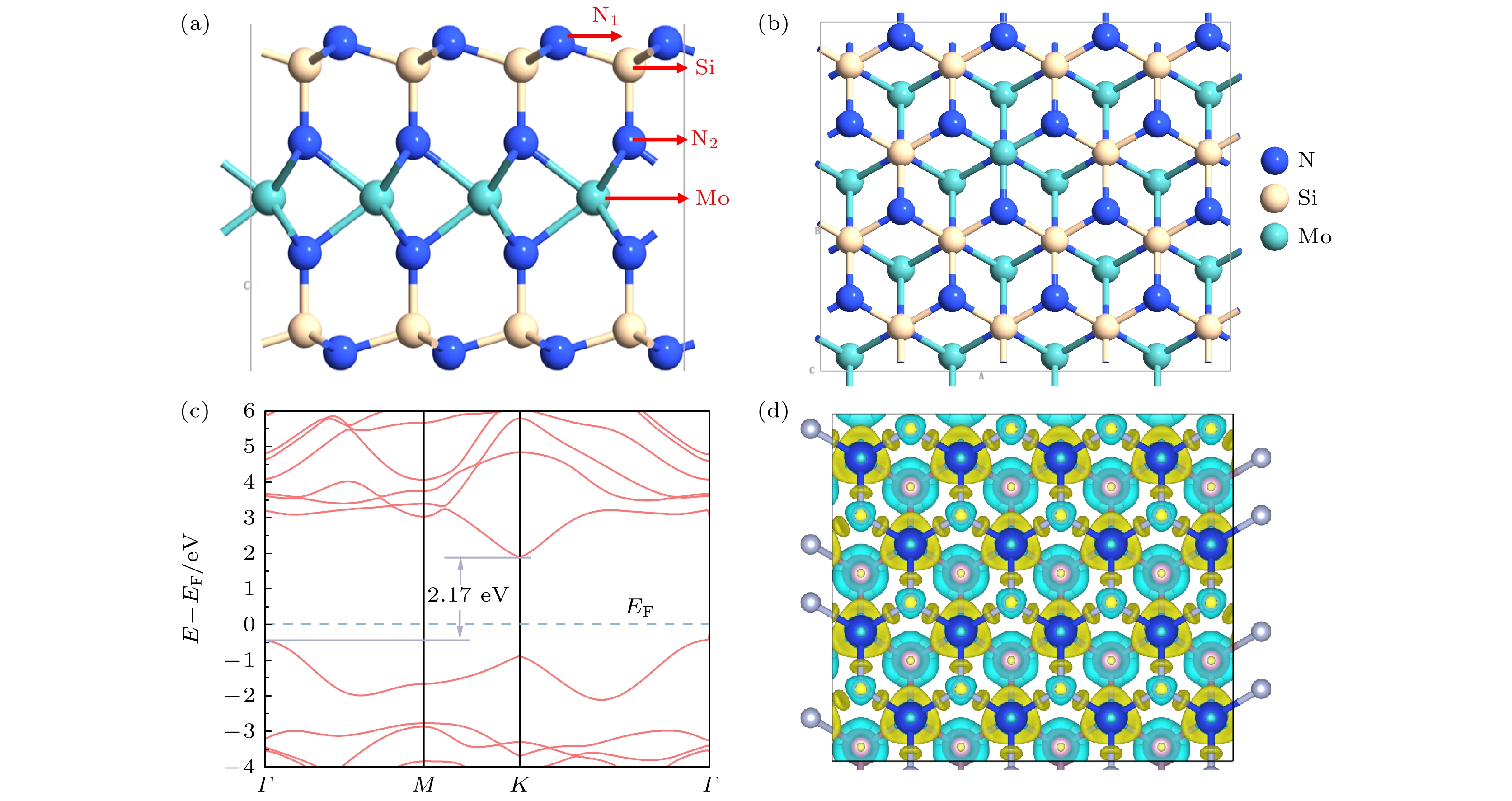
 DownLoad:
DownLoad:
